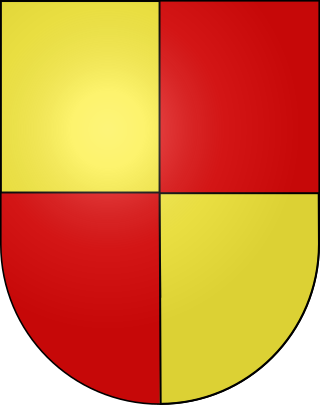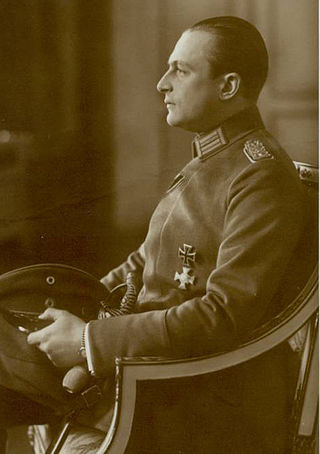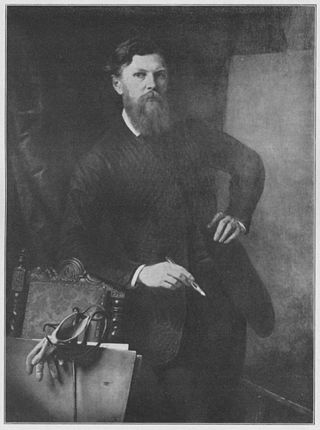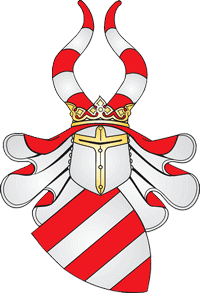
The House of Kalckreuth is the name of an ancient and important German noble family that originated in Saxony.

The House of Kalckreuth is the name of an ancient and important German noble family that originated in Saxony.
The family was first mentioned in a document on December 16, 1284 with Heinricus dictus de Kalcruthe on Lyce near Dresden . Conrad von Kalckreuth appears in a document on December 6, 1286. In early 14th century, several lines appeared that spread widely throughout Silesia, but also in Lusatia, Brandenburg, Mecklenburg and Poland.
Family members were awarded with the title of Baron in 1678 . Brothers Hans Ernst (1728-1792) and Friedrich Adolf, Count von Kalckreuth, who were raised to the Prussian count status in 1786 , founded the two lines of the comital family.

Friedrich Adolf Graf von Kalckreuth was a Prussian Generalfeldmarschall.

The House of Lichnowsky or House of Lichnovský is the name of an influential Czech aristocratic family of Silesian and Moravian origin, documented since the 14th century.
Finck refers to:

The Waldersee family is an old German noble family, representing illegitimate branch of the House of Anhalt-Dessau.

Leopold Karl Walter Graf von Kalckreuth was a German painter, known for portraits and landscapes.

The Reventlow family is a Holstein and Mecklenburg Dano-German noble family, which belongs to the Equites Originarii Schleswig-Holstein. Alternate spellings include Revetlo, Reventlo, Reventlau, Reventlou, Reventlow, Refendtlof and Reffentloff.

The House of Bismarck is a German noble family that rose to prominence in the 19th century, largely through the achievements of the statesman Otto von Bismarck. He was granted a hereditary comital title in 1865, the hereditary title of Prince of Bismarck in 1871, and the non-hereditary title of Duke of Lauenburg in 1890. Several of Otto von Bismarck's descendants, notably his elder son Herbert, Prince of Bismarck, have also been politicians.
The House of Schulenburg is the name of an old German noble family that goes back to 13th century. Members of the family held the title of Imperial Count. They had multiple political and military roles in the history of Germany and Great Britain.

Adolphus Frederick VI was the last reigning grand duke of Mecklenburg-Strelitz.
Arnim is a German surname, often preceded by the nobiliary particle "von", meaning "of". Notable people with the surname include:

The Second Battle of Wissembourg from 26 December 1793 to 29 December 1793 saw an army of the First French Republic under General Lazare Hoche fight a series of clashes against an army of Austrians, Prussians, Bavarians, and Hessians led by General Dagobert Sigmund von Wurmser. There were significant actions at Wœrth on 22 December and Geisberg on 26 and 27 December. In the end, the French forced their opponents to withdraw to the east bank of the Rhine River. The action occurred during the War of the First Coalition phase of the French Revolutionary Wars.
Events in the year 1904 in Germany.

The Brockdorff family is a Schleswig-Holsteiner old noble house that belonged to German and Danish nobility.
Berlepsch is a German surname. Notable people with the surname include:

The Bassewitz family is a German noble family of ancient nobility, whose roots come from the Mecklenburg region. According to tradition, the family was named after the village of Basse. In German hunter-language, Basse refers to a tusker or adult male wild boar. A Tusker Courant is the family's heraldic animal.

The Schlieffen family is the name of an old German noble family from Pomerania. The family, branches of which still exist today, originates in Kolberg.
The Battle of Biesingen took place during the War of the First Coalition on 17 November 1793 at Biesingen, now a district of Blieskastel. It occurred between a Prussian force under General Friedrich Adolf von Kalckreuth and a French one under General Louis-Lazare Hoche, ending in a Prussian victory.

Count Stanislaus Friedrich Ludwig von Kalckreuth was a German painter who specialized in mountain landscapes.

The House of Arnim is the name of an ancient German noble family, originally from Altmark, part of the mediaeval March of Brandenburg. Members of the family occupied many important positions within Holy Roman Empire, Saxony, Prussia, German Empire and the German Reich.

Count Ferdinand von Harrach zu Rohrau und Thannhausen was a German aristocrat, landscape, history, and a portrait painter.